
Heinrich Gottlieb Ludwig Reichenbach was a German botanist and ornithologist. It was he who first requested Leopold Blaschka to make a set of glass marine invertebrate models for scientific education and museum showcasing, the successful commission giving rise to the creation of the Blaschkas' Glass sea creatures and, subsequently and indirectly, the more famous Glass Flowers.

Heinrich Gustav Reichenbach was a botanist and the foremost German orchidologist of the 19th century. His father Heinrich Gottlieb Ludwig Reichenbach was also a well-known botanist.
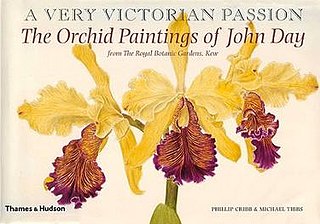
John Day (1824–1888) was an English orchid-grower and collector, and is noted for producing some 4000 illustrations of orchid species in 53 scrapbooks over a period of 15 years. These scrapbooks were donated to The Royal Botanic Gardens, Kew in 1902 by his sister, Emma Wolstenholme.The standard author abbreviation J.Day is used to indicate this person as the author when citing a botanical name.
Friedrich (Fritz) Wilhelm Ludwig Kränzlin was a botanist associated with the Natural History Museum (BM).

Aerides emericii is a species of epiphytic orchid. It is endemic to the Andaman and Nicobar Islands in the Bay of Bengal.
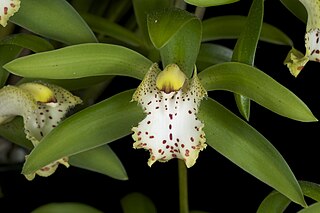
Cymbidium hookerianum is a species of orchid found in India, China, and Vietnam. It is distributed widely in Bhutan, especially in the cool temperate forests.

Dendrobium discolor, commonly known as antler orchids, are epiphytic or lithophytic orchids in the family Orchidaceae. They have cylindrical pseudobulbs, each with between ten and thirty five leathery leaves, and flowering stems with up to forty mostly brownish or greenish flowers with wavy and twisted sepals and petals. Antler orchids occur in northern Australia, New Guinea and Indonesia and there are several subspecies and varieties.

Dendrobium gratiosissimum, the very graceful dendrobium, is a species of orchid. It is native to Thailand, Vietnam, Laos, Myanmar, Yunnan, and Assam.
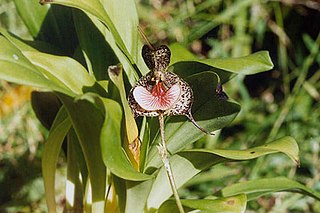
Dracula chestertonii, commonly known as the frog's skin, is a species of orchid endemic to Colombia.
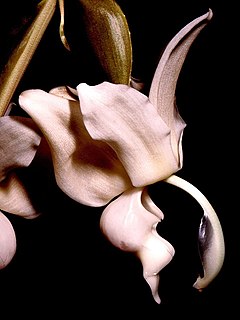
Stanhopea reichenbachiana is a species of orchid occurring from western Colombia to Ecuador. It is named for the botanists Philip Henry Stanhope, 4th Earl Stanhope and Heinrich Gustav Reichenbach.
Bulbophyllum trigonopus is a species of epiphytic orchid that is found in Borneo and from Thailand to Malaysia. It was first formally described in 1881 by Heinrich Gustav Reichenbach who gave it the name Cirrhopetalum trigonopus and gave Bulbophyllum trigonopus as a synonym. The description was published in The Gardeners' Chronicle along with the first formal description of Cirrhopetalum abbreviatum. In 2017 Poh Teck Ong changed the name to Bulbophyllum trigonopus and the change has been accepted by the World Checklist of Selected Plant Families with Cirrhopetalum abbreviatum now regarded as a synonym of Bulbophyllum trigonopus.

Vanda sanderiana is a flower of the orchid family. It is commonly called Waling-waling in the Philippines and is also called Sander's Vanda, after Henry Frederick Conrad Sander, a noted orchidologist. The orchid is considered to be the "Queen of Philippine flowers" and is worshiped as a diwata by the indigenous Bagobo people.

Dendrobium johannis, commonly known as the chocolate tea tree orchid, is a species of epiphytic or lithophytic orchid native to Australia and New Guinea. It has spindle-shaped pseudobulbs, between five and ten dark green leaves with purplish markings and flowering stems with up to fifteen chocolate brown flowers with a yellow labellum.

Dendrobium striolatum, commonly known as the streaked rock orchid is a species of orchid endemic to eastern Australia. It is a small, usually lithophytic orchid with wiry stems, cylindrical leaves and flowering stems with one or two yellow, cream-coloured or greenish flowers with reddish stripes. It often grows on cliff faces in New South Wales, Victoria and Tasmania.

Dendrobium bullenianum is a member of the family Orchidaceae found in the Philippines and Vietnam. It is named in honor of Mr. Bullen, orchid cultivator with Low & Co.'s nursery, who was first in Britain get this species to flower in cultivation. It is pendulous and sympodial with 1 meter long pseudobulbs of 1.5 cm thickness and deciduous leaves of 10 cm by 1.5 cm. Heinrich Gustav Reichenbach was the first to describe this species in 1862 in Botanische Zeitung. It is found as an epiphyte in elevations up to 1,000 metres in Luzon and Mindoro in the Philippines.
Dendrobium macropus, commonly known as the Norfolk Island cane orchid, is a species of epiphytic or lithophytic orchid in the family Orchidaceae and is endemic to Norfolk Island. It has cylindrical pseudobulbs, thin, dark green leaves and between five and ten yellowish green flowers that do not open widely.
Dendrobium brachypus, commonly known as the dwarf cane orchid, is an epiphytic or lithophytic orchid in the family Orchidaceae. It has crowded, yellowish green pseudobulbs, dark green leaves and two or three cream-coloured to whitish or greenish flowers which often do not open fully. It grows on trees and rocks on one mountain on Norfolk Island.
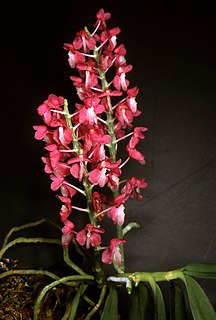
Dyakia is a genus of orchids. It contains only one species, Dyakia hendersoniana(Rchb.f.) Christenson, endemic to the Island of Borneo.

Phaius tankervilleaevar.bernaysii, also known as the yellow swamp orchid, is a species of orchid endemic to a small area of Queensland. It is an evergreen, terrestrial herb with large, crowded pseudobulbs, large pleated leaves and flowers that are white on the outside and sulfur yellow inside. Apart from flower colour, the species is identical to P. tankervilleae var. bernaysii.
Dendrobium insigne, commonly known as the mangrove tartan orchid, is a species of epiphytic or lithophytic orchid native to New Guinea and Indonesia. It has crowded, cane-like stems with many leaves arranged in two vertical rows, and short-lived yellow and red flowers in groups of two or three.















